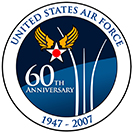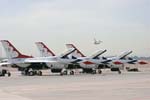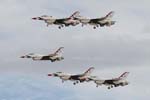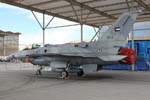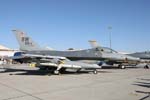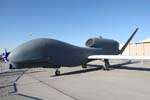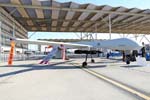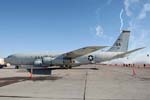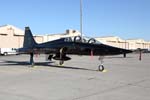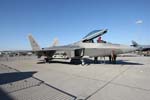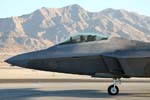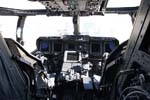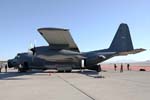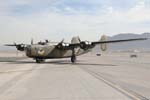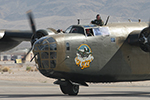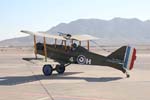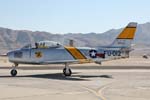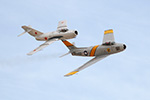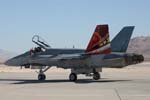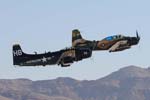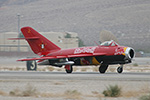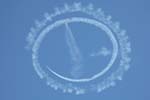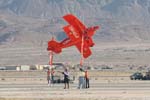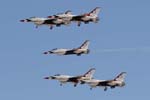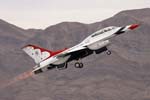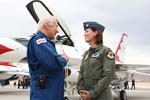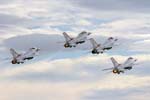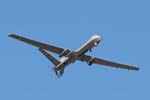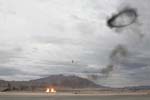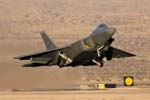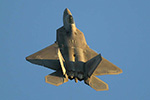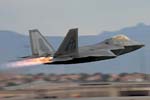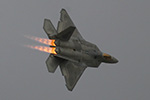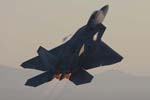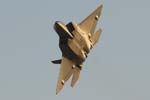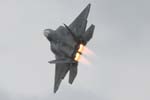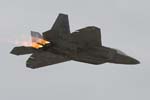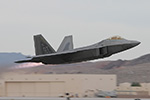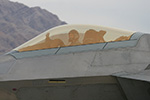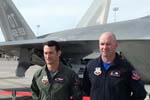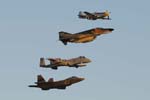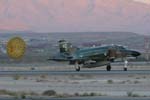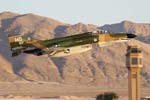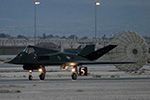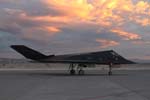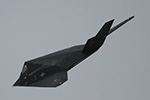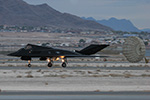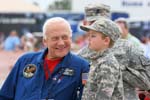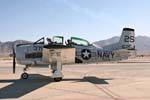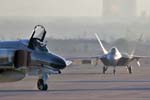When the National Defense Act of 1947, signed by President Harry S. Truman, came into effect on 18 September 1947, the Department of the Air Force was formed from the pre-existing United States Army Air Force and thus the United States Air Force, as we know it today, was born. Although only being sixty years old makes the USAF a relatively young force in the grander scheme of things, a sixtieth birthday is worth celebrating. Numerous events throughout 2007, and not just in the continental US, commemorated the occasion but Aviation Nation 2007 at Nellis AFB was the “capstone event” of this anniversary year and was also the last show of the USAF Aerial Demonstration Squadron “Thunderbirds” 2007 schedule. With all that in mind, the bags were packed, batteries were charged, camera lenses cleaned and off we went for a week in Sin City, er, I mean Las Vegas. |
|
|
It was the drive in to Nellis AFB that emphasised just how huge the place is – there’s a chance we drove through four zip codes just getting from the main gate to the car park! The static line-up was something else too! OK, it couldn’t match the likes of RIAT for sheer numbers or the diversity of nationalities but that is a mute point and, I feel, utterly irrelevant. Putting it slightly differently, you didn’t have to look very far to find the gems and to be quite honest, it was like being a kid in a sweetshop. For instance, parked under one of the sunshades were two F-16s – now, whilst you may initially think “so what they’re only F-16s”, one was a Dutch MiG-killer from 322 Squadron (it would appear that no matter where you go, even if it’s 6,000 miles further west, you just can’t escape Dutch Vipers – and that goes for the Serbian MiG-29 too!) whilst the other was a very smart looking United Arab Emirates AF Block 60 F-16F Desert Falcon, operated by the Arizona ANG’s 162FW at Tucson to train UAE pilots on the F-16E/F. The Block 60 F-16E/Fs are pretty much an evolved Block 50/52 F-16C/D but could equally be called the “Super Fighting Falcon” as there are more changes than meets the eye. For a start, the General Electric F110-GE-132 provides a maximum thrust of more than 32,000lb with the afterburner lit and is the most powerful engine ever bolted in the back of an F-16 – given the numerous lumps and bumps of the Block 60 and where they are flown, the extra thrust should be quite useful. By far the most obvious features are the two conformal fuel tanks bolted to the sides of the fuselage over the wings which provide an additional 3,000lb of fuel and will extend the range by 25% - not to mention, when viewed nose on, giving the Viper a pair of imp-like pointy ears. |
On previous F-16s, when you needed to use a targeting pod, they needed to be hung on the aircraft – the LANTIRN-equipped F-16C/D Block 40/42s are a great example of this in so much as the two pods were mounted on either side of the air intake – on the Block 60, this is no longer the case. The AN/ASQ-28 Internal FLIR and Targeting System (IFTS) is all located internally with the exception of a small ball turret above the nose, forward of the cockpit and replaces heavy and bulky pods that would ordinarily need to be used. It is also in the nose where another major change lurks although you wouldn’t know by looking – the Block 60s all have a Northrop-Grumman AN/APG-80 AESA radar which gives the F-16E/F twice the air-to-air detection range of AN/APG-68-equipped F-16s. Incidentally, this made the Block 60s only the third type, behind USAF F-15Cs and F-22As, to fly with an AESA radar and all Block 60s are also fitted with a “Falcon Edge” ECM suite that is rumoured to be a little bit more than good. Basically, the Block 60 F-16s (that the UAEAF paid $3B for the development of!) are the most advanced and capable F-16s on the planet – certainly well in front of anything in the US fleet. A further three Vipers were to be found lurking in the static park – one being a Nellis-based 16th WPS Tomahawks F-16CG, looking rather mean and menacing with a 2,000lb GBU-24 Paveway III under each wing and a 55th FS Fighting Fifty-Fifth F-16CJ (complete with a pair of AGM-88 HARMs) from Shaw AFB in South Carolina. |
|
|
The third was a very tidy looking F-16C from the based 64th AGRS, wearing a fetching brown aggressor scheme complete with Soviet style markings. This particular machine was parked alongside its bigger, but similarly ‘aggressive’, cousin – a 65th AGRS F-15C, itself looking quite business-like thanks to the two-tone blue wraparound camouflage and, again, Soviet-esque markings. Flown in the opposing force (OPFOR) / “Red Air” role against “Blue Air” friendlies, the 64th and 65th AGRS units provide realistic air threats to prepare US and allied air crews for combat based on the relatively obvious notion that combat is not the place to learn your trade; it’d be a bit like learning to drive in a works rally car. At night. In fog. In a forest. Using tactics that an assumed enemy would use, allied crews get to fight the “enemy” without needing to go head to head with a foe over some far flung foreign land – and if they get ‘shot down’, they get to learn from it and what they should or shouldn’t do in future aerial disagreements. With all the elements taking part in massive exercises like Red Flag, it’s as close to war as they can get without, well, going to war. |
Having recently moved out of Nellis and up the road to Creech AFB near Indian Springs, the 432nd Wing brought a couple of their ‘aircraft’ back to their first home – an 11th RS MQ-1B Predator and an 42nd ATKS MQ-9A Reaper. They were parked alongside the biggest UAV in operation, an RQ-4A Global Hawk, but as this was once again a large Airfix kit we’ll gloss over it on the grounds that it doesn’t quite count. Though the Global Hawk is probably the most over stretched UAV system in the USAF, it would be nice to see a real one sometime. Now, back to the Predator and Reaper… as a MALE (Medium Altitude Long Endurance) UAV the Predator can hang about for more than 24 hours just keeping an eye on what is or isn’t happening 25,000ft below and though, for instance, the UAV part of the system may be flying over the mountains of goodness knows where yet the pilot and sensor operator could be sat in air conditioned comfort at Creech. Initially designated the RQ-1, the Predators were originally intended for reconnaissance but that soon changed when, following the 9/11 terrorist attacks, AGM-114 Hellfires were shipped to Predator units in Afghanistan to be hung from the dainty wings of their RQ-1Bs. In 2002, to reflect the armed ‘multi-mission’ role of the RQ-1B, the USAF re-designated them to MQ-1Bs. |
|
|
The MQ-9A Reaper on the other hand is a slightly different kettle of fish piranha. Basically, the Reaper is a bigger version of the Predator and at one time was even called the RQ-9 Predator B. With a bigger, meatier engine and a bigger fuselage with bigger wings, the MQ-9 can carry more ordnance to a greater height and at a greater speed than its MQ-1 little brother and is pretty much a proper attack platform with an ability to carry about 3,750lb of munitions. A little more than a week before the show, the MQ-9 had notched up its first combat kill in Afghanistan after an AGM-114 was sent on its merry way to deal with insurgents in the Deh Rawood region of Oruzgan, central Afghanistan. Thus, the MQ-9 is pretty much the latest combat aircraft in the USAF inventory and even though it’s little more than a radio-controlled aircraft, it does look one mean bit of kit! Also currently out at Creech is the RAF’s 39 Squadron who now have two of their very own Reapers to cause havoc with and in fact, just a day before the show, the MoD had announced that RAF Reapers had begun combat operations over Afghanistan. |
Further representatives of the intelligence gathering community were a 38th RS RC-135W Rivet Joint, a 16th ACCS E-8C J-STARS and a 960th AACS E-3C Sentry. Curiously though, and for reasons I know not, the E-3 was surrounded by a red rope and “Use Of Deadly Force Authorized” signs yet nothing else was given the same treatment. Launching what wasn’t all that far adrift of a “Texas Invasion” were no less than five types that call some part of Texas home. At the top of the pecking order was Phoenix, a 28th BS Mohawk Warriors B-1B Lancer from Dyess AFB; representing Randolph AFB were a 90th FTS Boxing Bears T-38C Talon in a rather smart two-tone grey camouflage scheme and a 99th FTS Panthers T-1A Jayhawk; the final Texans were from Laughlin AFB – an 84th FTS Panthers T-6A Texan and an 89th FTS Banshees T-37B Tweet. Excluding the B-1B, this lot basically covered most USAF trainer types from initial flight training aircraft right up to front line fast jet and multi-engine trainers. Even the USAF Academy at Colorado Springs had sent an aircraft along – a 94th ATS T-41D Mescalero. Although named after an Apache Indian tribe of New Mexico, the T-41D isn’t quite as exotic as it sounds as it is simply a military version of the Cessna 172 and used for cadet flight training. Had there been a B-2A in the static, then the full trio of USAF strategic bomber types would have been out basking in the sun as, making a fine sunshade for many, a 20th BS Buccaneers B-52H had made the not inconsiderable jaunt from Barksdale AFB in Louisiana. Although Spirits are notoriously shy when it comes to being parked up at an airshow (probably because it’s not dark enough), it would have been nice at the official birthday party to have had the full spectrum of “stealth”, not to mention the bombers, out on show. |
|
|
The B-2 might not have made it, but Team Holloman sure did! Both types flown by the 49th FW were at the show and it provided one last chance to see their T-38s and F-117s – plus a stunning QF-4E drone in a pale-bellied South East Asia “Heritage Flight” scheme. Intentional or not, parking the Nighthawk alongside the Raptor, a type that will be replacing the F-117, was somewhat of a stroke of genius. It also, without being Minister for Stating the Glaringly Obvious, showed the massive differences between First Generation Stealth (the F-117) and Third Generation Stealth (the F-22) – the F-117 is all angled surfaces and it looks like it needs magic to fly whereas the F-22 has curves and looks like it’s shifting at a rate of knots even when standing still. In case you were wondering, the B-2 is Second Generation Stealth. However, the whole thing is a tad bitter sweet as the USAF are retiring the F-117, still more than capable of putting 2,000lb bombs straight through an air vent, to free up funds for the F-22. Taking up the static duty were the 8th FS Black Sheep, whilst the 9th FS Flying Knights handled the flying display – these two units are the only F-117 operators in the USAF. As for the 7th CTS Screamin’ Demons T-38, well, it was a black one so that’s all that needs to be said! A very tidy looking machine indeed. |
In addition to the 16th WPS F-16, 64th AGRS F-16C and 65th AGRS F-15C, examples of the rest of Nellis’ aircraft that weren’t hustled away from the crowds were wheeled out of their hangars into what amounted to an impressive line up of hardware. I’ll get back to the USAF’s new toy in just a while but dominating this particular line-up was an immaculately turned out 17th WPS Hooters F-15E Strike Eagle – there wasn’t a pylon fitted that didn’t have something dangling off it and no, it wasn’t wearing tight orange hotpants. AGM-130s and AIM-9s were on the wing pylons plus twelve, yes, twelve, Mk 82 500lb unguided bombs were on the conformal fuel tank hardpoints. It almost gives the up-to-no-good sorts an option for how bad they want their day to be. Officially first used in combat in 1999 against Iraqi air defence positions, AGM-130s can only be hauled by the Strike Eagle and are essentially glide bombs with a rocket motor lashed on – GPS-aided INS guidance can take the 3,000lb monsters to roughly where they need to be and then terminal guidance can be achieved through the clever electro-optical seeker and datalink. Parked up alongside was a 433rd WPS F-15C which, although itself was well turned out and presentable, looked, well, a bit weak and weedy compared to the fully tooled up Mudhen! |
|
|
Arguably (aka temporarily ignoring something called a “Raptor”), the surprise was the 422nd TES Green Bats Warthog – it looks like a Warthog, it’s called a Warthog and earlier in it’s life it was a Warthog but it’s a fundamentally slightly different Warthog and one that drags the A-10 right into the 21st Century. Current A-10As are knocking on a bit in terms of years and in what they can or, more specifically, can’t do but the only replacement for an A-10 is an A-10… so, what do you do? Easy. You take the ageing A-10A and put it through the Precision Engagement Upgrade Program (putting it this way seemingly simplifies the concept of moving from the old systems to the new entirely digital systems to give them the ability to employ the latest generation of targeting pods, GPS guidance, smart weapons such as the JDAM) and hey presto, you have a nice shiny new A-10C. Also, like the MQ-9, the A-10C has also recently been used in combat thanks to the 104th EFS (which is predominantly made up of 175th FW / Maryland ANG personnel) who were the first to take the new aircraft into combat from their operating base at Al Asad AB, Iraq in September. In fact, the first combat drop of a JDAM from an A-10C occurred not so long ago on the 19th of September, just weeks after arriving in theatre. |
Split off from the rest of the Nellis herd, were two entirely different machines. Following a not inconsiderable investment of more than $60 billion, the F-22 is undeniably the most expensive fighter aircraft ever developed – but for that $60B, the USAF also has, hands down (or up, it makes no difference), the most advanced fighter aircraft ever developed. Which, as it happens, is quite handy considering their current top-of-the-pecking-order fighter, the F-15C Eagle, is showing its age – initially equipping the 555th TFS back in 1976, the youngest Eagle is still 21 years old. The Raptor though is not so much in a whole different league but is playing by a whole new set of rules on quite a different pitch. It can do everything the Eagle can do, only better. A bit pricey mind, but if you want the best, you’ve got to pay for it. The example dragged into the static line-up was from the Nellis-based 422nd TES Green Bats whose role is to develop and publish new tactics and to conduct operational tests for Air Combat Command on A-10s, F-15s, F-16s, HH-60G and, obviously, the F-22A. Roughly the same size as the Eagle, the F-22 has a much larger wing area (some 38% greater in fact) and is also a heavier beastie – it doesn’t look, in my own opinion of course, quite so photogenic as the Eagle when parked up but I can’t imagine Lockheed-Martin had this kind of thing in mind when they entered the Advanced Tactical Fighter competition back in 1986. Whilst parked up though, it does provide the opportunity to have a look at the latest and greatest toy that USAF have got their paws on. As if the advanced design and fancy materials aren’t good enough, everything, and I do mean everything, is pretty much completely hidden beneath the Raptor’s skin and “sticky out things” are extremely rare, thus helping to keep the Raptor off a radar screen. |
|
|
The second machine, dragged the few hundred metres down the ramp from its usual home to mingle amongst the Special Operations contingent, was a 66th RQS HH-60G Pave Hawk. Bristling with lumps, bumps and Miniguns, Pave Hawks do look good; not quite as good as the menacing mass of the MH-53M, but good nonetheless – they probably look even better to personnel they’ve gone in to fetch out of harms way though. The 66th RQS is actually part of the 23rd Wing at Moody AFB in Georgia but are based at Nellis and, in addition to providing SAR support for the region, train many personnel for the CSAR role; incidentally, they were the first CSAR unit into Afghanistan (and are currently providing personnel to support two forward operating locations). On the brief subject of the MH-53M, it’s replacement in SOCOM for going in somewhere ‘not exactly friendly’ to do whatever it is they’re going in to do, was stuck on display for all to see – the CV-22A Osprey. This particular example was one of a pair of Kirtland AFB-based 71st SOS Ospreys at the show, one of which was due to participate in the flying (of which more later) whilst this one got to put up with the public climbing through it. Wearing a typically sinister two-tone grey and almost black, scheme, the CV-22As certainly fit the part of nocturnal, sneaky-beaky, Special Operations birds… although the insides are, well, industrial at best. |
Still, if you’ve been shot down somewhere you don’t really want to be, I can’t see exposed wiring and pipes being at the top of your list of current concerns. Number one is perhaps “where are they?”, number two is probably “I hope they bring SEALs” and exposed wiring is likely to be down at about number 327. The 71st SOS crews are more than happy with their new chariot so, based on this little fact (i.e. those that we spoke to that will be actually flying into harms way in the said aircraft seem to love the things), surely that’s all that matters for the Osprey program. Rounding out the SOCOM representation was a pair of “Fat Alberts”… one being a 9th SOS MC-130P Combat Shadow from Eglin AFB in Florida and the other being a 711th SOS MC-130E Combat Talon I from Duke Field, near Eglin. Whether or not the sneaky beaky “Alberts” will work with the Osprey force to quite the same extent as the MH-53 fleet has done remains to be seen – but Ospreys will undoubtedly need in-flight refuelling support at some point. |
|
|
Heavies were very well represented courtesy of an example of both strategic airlifters and both tanker types – not a bad showing when you consider how stretched both these fleets are. Travis AFB’s 60th Air Mobility Wing provided both the C-5C Galaxy (22nd AS) and KC-10A Extender (6th ARS) for the duration of the show yet the C-17A Globemaster and KC-135T Stratotanker came from somewhat further a field. The C-17A, assigned to the 58th AS, is normally to be found lurking around Altus AFB in Oklahoma when it’s not hauling cargo around the world and the 92nd ARS KC-135T normally calls Fairchild AFB up in Washington home. Interestingly, the C-5C is one of just two such aircraft specially modified for the carriage of satellites and other large payloads (such as bits of space stations, rockets, etc) for NASA yet also has a fairly typical military use if a particular load won’t fit in a ‘normal’ C-5. A very neat touch was parking the Galaxy tail on to an entrance gate such that the first thing most people coming in through that particular gate did was walk through the 1,000 flag memorial to fallen American personnel and then the full 140-odd feet of the cargo compartment. |
Concentrated down at one end of the static ramp near the Galaxy were numerous warbirds and civilian aircraft; the gem being “Skidoo”, a P-38J Lightning painted in the markings of Col. Perry J. “PJ” Dahl, a 475th FG pilot who flew combat missions in New Guinea and the Philippines. Running it close however was “China Doll”, a C-46F Commando looked after by the Southern California Wing of the Commemorative Air Force. Also located at this end of the ramp was the flightline for the warbirds taking part in the flying display and if you were to consider this little enclave a static park, even though off limits, ladies and gentlemen, we have ourselves a new static star – Ol’ 927, one of only two B-24s left flying. This particular machine is the oldest B-24A Liberator in existence being number 25 off the Consolidated line and part of an order of twenty “LB-30As” for the RAF – crashing near Albuquerque in July 1941, Ol’ 927 never made it to the UK. Consolidated rebuilt her to a transport configuration and flew, for Consolidated, between San Diego, Fort Worth and New York until being sold to the Continental Can Company. She was then sold on again, this time into Latin America with Patroleos Mexicanos until the Commerative Air Force (more specifically Confederate Air Force as they were back then) got their hands on her in 1967. Between 1971 and May 2007, Ol’ 927 flew in the markings of the 9th Air Force’s 98th Bomb Group and named Diamond Lil; in May 2007 she was given a new paint job, new nose art and the name Ol’ 927 (which comes from her time flying between San Diego, Fort Worth and New York as AM-927). |
|
|
With the exception of a couple of practice displays by Sean D. Tucker and Ed Hamill, the flying display was kicked off with a flypast by WW1 era aircraft which was swiftly followed up with a flypast by five Boeing PT-17 Stearmans, led by Lt Col. Roger Parrish (an F-4 driver during the Vietnam War and the Leader of the Thunderbirds in 1973/1974) which represented the inter-war trainers. Two B-25J Mitchells (Executive Sweet and Heavenly Body), a single C-47, P-51D Mustang “Ridge Runner II”, Spitfire Mk IX, A6M3 Zero, B-17G Flying Fortress “Liberty Bell” and B-24A Liberator “Ol’ 927” then took to the air prior to the World War 2 re-enactment. Initially, the B-25s had the run of the Nellis airspace as part of commemoration of the famous Doolittle Raiders. Sixteen B-25Bs were somehow shoehorned onto the Yorktown-class USS Hornet (CV-8) with her normal airwing housed on her hangar deck and headed for the Western Pacific and Japan – 650 miles off shore, the sixteen B-25Bs were launched from the Hornet, destination Honshu. Six hours later, targets in Tokyo, Yokohama, Nagoya and Kobe were attacked marking the first time mainland Japan had been hit by US forces... you’ve certainly got to admire the crews that took part in this legendary raid and as it was a volunteer mission, one can only presume the volunteers had balls of steel. Whilst the B-25s were making their passes, pyrotechnic charges were being let off simulating bombing runs. Eventually, the other airborne assets got involved – the Zero was chased by the Spitfire, the B-25s were escorted by the P-51 (a role for which the Mustang was built) and the B-17 and B-24 also made pyro-assisted bombing runs. A number of passes were made by all types and even I have to say I was extremely impressed by this display not to mention the height, rather lack of, that the B-17 and B-24 were making their flypasts at. They may well have needed Dale Snodgrass to get much lower. |
In the second war re-enactment of the show, a Firefly AS.6, Sea Fury FB.11, T-33A Shooting Star (presumably masquerading as an F-80), F-86F Sabre, MiG-15 Fagot, a pair of Skyraiders, a pair of O-1 Bird Dogs and a pair of T-28 Trojans brought the Korean conflict back to life. Unlike out in Korea where USAF Sabres were outnumbered by MiG-15s by about 8:1 (better training resulted in an 8:1 kill ratio in favour of the Sabres), in the Nevada skies it was a much more equal 1:1 contest between the two pioneers of jet combat. Whilst these two were performing tail chases and thus representing the MiG Alley engagements, the rest of the participants were busy with a spot of Korean countryside regeneration. Chief amongst the culprits of this redecoration were the Sea Fury and Firefly – one of just twenty-four surviving Fireflies and one of the first Mk 6s to be built albeit with a Mk 5 fuselage, this particular AS.6 variant first served with the Royal Australian Navy before being stuck on a pole in New South Wales. Eddie Kurdziel bought the said memorial and, following an extensive restoration by QA Aviation of North America in Fort Collins, brought her back to airworthy condition – and a great job everyone did with her too. Following the tragic loss of the last airworthy Firefly in the UK back in 2003, it was great to see a Firefly back in the air. The Sea Fury, in this case, an FB.11, was also a great sight to see – not to mention it sounded fantastic. Flown from HMS Ocean, HMS Glory and HMS Theseus, the Sea Fury replaced the less robust Sea Fire in the ground attack role and proved to be a very useful platform… on 27th July 1952 Lt “Hoagy” Carmichael, flying an 802NAS aircraft off HMS Ocean, chalked up the first kill of a MiG-15 by a piston-engined aircraft, incidentally the only kill recorded by a British pilot in a British aircraft in the skies over Korea. Pyrotechnics were used throughout the re-enactment to enhance the spectacle by simulating bomb drops as the various aircraft passed by. |
|
|
For me, one of the highlights (F-22 not withstanding) of the flying display was the CF-188 Hornet display – it’s been a long while since I’ve seen the Canadian Bug demo and it didn’t disappoint. Capt. Yanick “Crank” Gregoire, the 2007 demo pilot with more than 800 hours on type, certainly knows how to get the best from the nimble Hornet and although many think the best Hornet display hails from Switzerland or maybe Spain, the Canadian team (just twelve personnel from 3 Wing Bagotville and 4 Wing Cold Lake!) put up one hell of a fight! I’d even go so far as saying the Canadian team is the best of all the Hornet displays – when it comes to Hornet manoeuvres, pretty much the full repertoire was shown off during the 13 minute slot, and shown off very well too!! Furthermore, the Canadians aren’t known for being shy when it comes to Hornets and cans of paint and 2007 was no different – the jet, from 410 Squadron “Cougars” at Cold Lake CFB, is painted in a scheme designed by Jim Belliveau (the Marketing & Design Director who has been responsible for RCAF Hornet schemes since 1994) to celebrate twenty-five years of the Hornet in Canadian service and, whilst a little restrained compared to some previous offerings, the “one blue, one red” tail scheme with stylised hornets is actually very smart. It is certainly much more colourful than the CF-188B that flew on Friday and the Hornets flown in displays by the Europe air forces – and thinking about it, a good number of US Navy F/A-18C CAG birds aren’t this colourful. |
Perhaps the most entertaining of the various re-enactments was the Vietnam scenario – that being the rescue of a downed airman behind Vietnamese lines and the provision of close air support for this rescue. Flying the “sandy” mission was a pair of A-1s - an AD-4N and an A-1E – both in absolute tip-top condition. The AD-4, in a rather conservative all-over dark blue USMC scheme, lost out to the terrific A-1E in its South East Asia scheme in the looks stake; not to mention the fact that the twelve rockets and two bombs made the A-1E look the part. Providing top cover would be an AC-47 Spooky gunship (a bit of imagination was required as the actual aircraft was a C-47B Skytrain; although it did have Spooky noseart!) together with a T-37 in the forward air controller role. Interestingly, both the A-1E and T-37C (representing an A-37) carried the markings of the Viet Nam Air Force’s 524th Fighter Squadron yet the squadron didn’t actually fly the two types concurrently in combat – originally flying A-1Es from Thien Loi, the unit transitioned onto the much quicker T-37C in late 1969 at Nha Trang. Assigned to fetch the downed airman back were a pair of UH-1 Iroquis’ although I can’t help but think what lead up to their appearance should have come after they had left the area. |
|
|
Representing the “Arc Light” B-52 operations over Vietnam, a single 11th BS B-52H made a simulated bombing run – you just would have thought that a BUFF run would have been best made after survivors had been plucked to safety. Even an over-active imagination would be hard pressed to suddenly imagine the area in which the Sandy’s and Spooky were working wasn’t actually the same area pummelled back to the dark ages by a full B-52 bomb bay. A definite highlight of the re-enactment was the two UH-1B Iroquois’ – they’re seldom seen at UK airshows, much less a feature of a flying display. Whilst both looked good, particularly the one bristling with enough weaponry to cause untold grief and mayhem, the sound of a pair of Hueys is something else! Pyrotechnics were craftily brought into the mix to simulate marker rounds, gunfire and the like, which just added to the enjoyment and with all the radio chatter, it was actually a very entertaining, well thought out, piece and it’s something UK shows could learn a thing or two from. |
It seems quite ‘odd’ that at the home of the US fighter pilot, two Russian MiGs were amongst the participants yet I can honestly say I’ve never seen either the MiG-15 or the MiG-17 Fresco fly before… more bonus points to Aviation Nation then. As the MiG-15 was unstable at high speeds, too tight a turn could end up with the pilot having to walk home which isn’t at the top of many pilot’s lists. The MiG-17 is basically a stable MiG-15 with this being achieved through the addition of wing fences, a lengthened fuselage and the wings were swept back to 45° from the original 35°. Catch a fleeting glimpse of a MiG-17 and you could well think it was a MiG-15. This particular MiG-17 though wears a particularly conspicuous red and blue scheme with a huge Red Bull logo on the underside so perhaps isn’t quite authentic to original Frescos but at least it flies. Quite an impressive 12 minute routine was flown by Bill Reesman which included a number of aileron rolls and low passes, not to mention most of the display being conducted with full afterburner – but given the “vertical” climb to 12,000ft towards the end of the display, it probably needed the afterburner to get anywhere. As the highest time MiG-17 driver (with more than 1,100 hours) in the US, twenty-four years in the USAF (including 320 combat missions over Vietnam in F-100s) and being an ex-United Airlines training pilot, Bill certainly knew how to best show off the little Russian jet. |
|
|
A pleasant change to the norm when it comes to civilian acts was the Red Bull Air Force – and personally I think they must have more than a screw loose… they’re mad! Normal civilian ‘teams’ tend to be stick to one type of act, for instance, you either fly an aerobatic aircraft of some sort, fly a helicopter or jump out of a perfectly serviceable aircraft – not the Red Bull Air Force. This lot take these three entirely separate concepts and fill the helicopter with parachutists, who jump from said machine whilst the aerobatic aircraft circles them. Madness, complete and utter madness! Impressive to watch though and I don’t think the jumpers could have been accurate if they’d tried. Once the jumpers have landed, the helicopter struts its stuff in quite a seriously impressive routine. The MBB Bo105CBS is pretty much as MBB intended a Bo105 to be but what they maybe didn’t figure on was a guy by the name of Charles “Chuck” Aaron would be flying it; according to Red Bull this guy is the only pilot authorised by the FAA to perform helicopter aerobatics. I can’t say I’ve ever seen g limits referred to for a helicopter but Red Bull’s Bo105CBS has them (+3.1g, -1.0g) although Eurocopter engineers were needed to find this rather pertinent piece of information. Loops? Check. Rolls? Check. Backflips? Check. Completely mad pilot? Check. Good display? Check! |
Flying a one-of-a-kind tool built to do a job, it’s reasonable to assume Sean D. Tucker must be absolutely nuts – a highly modified Pitts Special would have suited most people just fine… not Sean though, after taking a Pitts Special to its limits, he and his team put together the Challenger II. Weighing just 1,200lbs with an engine holding in four hundred horses, this little biplane is one ridiculously agile little aircraft and quite how Sean can get out and walk after his fifteen minute display is anyone’s guess. It must be the equivalent of thinking it’d be a great idea to see what it’s like in a tumble dryer. Undoubtedly playing a big part in this ability is the fact that he has more than 20,000 hours in the cockpit and has completed more than one thousand displays; he is also the only civilian permitted to fly in close formation with either the Thunderbirds or the Blue Angels. Towards the end of the display, three groups of four volunteers get to wander out to the runway with 20ft poles with ribbons fastened between them – once there, the volunteers (who must also surely have a screw loose) whose groups are 750ft apart raise the poles for Sean to fly underneath the ribbons and then between the poles again, a little higher, to cut all three ribbons at what looks like 10-15ft above the runway. At the helm of the second aerobatic biplane to display was Ed Hamil. Ed, a Major in the USAF Reserves is an F-16 Instructor Pilot at Luke AFB but at eighteen shows over the course of a season, he gives up his weekend to throw the little biplane around in the name of advertising the USAF Reserves. The ‘aerobatic’ acts aren’t normally the kind of things that hold my interest but you have to hand it to both Sean and Ed – they are good! |
|
|
It’s hard to provide a definitive reason but American display teams on “home turf” are almost always better than when you see them elsewhere – for a start the atmosphere is just so much different and is literally like that at a sports event. Have you ever seen anyone stood at a show in the UK holding a sign that read “Go Red Arrows”… didn’t think so. Bet you haven’t seen people shouting, hollering and almost jumping about when even the ground crews wander out. Yes, the ground show drags on a bit and yes, it is somewhat over the top but the crowd seem to like it but given that the Thunderbirds sole reason for being is to be an ambassador for the Air Force, as pretty much the whole base comes to a screeching halt when someone so much as mentions “Thun…”, then there’s not a man, woman or child that can say that the team is ineffective. Perhaps not to European tastes but then again, in Europe, it’s probably now illegal to actually get behind and support a nation’s armed forces just in case someone is offended. The Nellis show spelt the end of the 2007 Thunderbirds season after kicking off their 39-event schedule at Luke AFB back in March but also marked the last show in which three of the six would take to the skies as Thunderbird demonstration pilots. Due to Major Chris Austin (#2, Left Wing) being ill about a week before the show, only five of the six took part in the display on Friday and it certainly looks bizarre when a dorito shaped formation flies past rather than the expected diamond – the team was back to full strength though for both the Saturday and Sunday displays. |
Whilst Europeans can argue that they’re technically not quite up to the standard of the likes of the Red Arrows (which a number of the Thunderbirds consider to be the best team in Europe although we won’t say which), Frecce Tricolori or Patrouille de France, the very fact that the jets aren’t trainers but bonafide combat capable (with a little work) F-16s, no-one can say that their display isn’t a great spectacle and it certainly looks like if they got any closer, you wouldn’t be able to swipe a credit card between them. Front line strike aircraft are not typically shown off like this. The spotless and damn near polished finish of the six Vipers looks absolutely great against the backdrop of Sunrise Mountain and clear blue sky – they don’t look so bad when it’s a bit grey and cloudy either to be fair! |
|
|
Although I haven’t personally seen the displays enough times to know precisely when someone has got something a little wrong, the displays did appear to be absolutely faultless but that’s not really much of a shock when you take into account that the six demonstration pilots have a total of 13,300 hours flight time (11,600 of those being in Eagles and Vipers) and all six have a combined Thunderbirds experience of about nine years. As briefly mentioned above, the team’s 4,122nd display at Aviation Nation 2007 brought to a close the two-season tenure of three of the six demonstration pilots – these being the Leader / Commanding Officer Lt Col. Kevin J Robbins; Right Wing Maj. Nicole Malachowski and Lead Solo Maj. Ed Casey – so the 4,222nd Thunderbird display on Sunday afternoon was also their last. Nicole, now off to pastures new at the Pentagon, and Maj. Samantha Weeks (Opposing Solo; the one guilty of scaring the living daylights out of the blissfully unaware with the sneak pass throughout 2007) together have been superb ambassadors for the USAF but Samantha gets one more year with the team as she moves to Lead Solo. For 2008, the Leader / CO will be Lt Col. Gregory Thomas, Right Wing will be Maj. Kirby Ensser and Opposing Solo will be Maj. Tyrone Douglas; further changes to the twelve officers are Advanced Pilot / Narrator Maj. Tad Clark being replaced by Maj. Anthony Mulhare and Flight Surgeon Maj. (Dr) Dan Mirski being replaced by Maj. (Dr) Charla Quayle. |
Twenty-four years ago, the Thunderbirds began flying Block 15 F-16A/Bs which were exchanged in 1992 for the slightly newer Block 32 F-16C/Ds that they still fly today – however, the first of their eleven “new” Block 52 F-16C/Ds was tucked up in their hangar, a place so clean and tidy it probably could embarrass some UK hospitals. They’re new as far as the Thunderbirds are concerned but, following Wild Weasel service with the 389th FS Thunderbolts at Mountain Home, they go through rather in-depth depot level service and maintenance at Ogden Air Logistics Center (OO-ALC) at Hill AFB such that they all get the Falcon STAR modification and have a smoke generation system installed. The last of eleven jets should be at Nellis by the beginning of November, ready for the first season with the new jets in 2009. The current Block 32s will, rather than be retired, be returned to a combat capable state by late 2009. Outwardly, there are two visible differences between the older Block 32 type and the newer Block 52 – by far the biggest give away is the array of little blade antennas forward of the canopy; the second major difference involves the paint. All current Thunderbird F-16s are painted with automotive grade paint whereas the Block 52s will be painted with proper aircraft paint. This means that they’ll be slightly shinier and more resistant to chipping caused by heavy rain and the like on leading edges. The reason for Block 52 is quite simple – all Nellis F-16s are Pratt & Whitney powered, so from the point of view of being able to support the powerplant, the replacement would need a Pratt & Whitney F100 bolted in the backend. As Mountain Home was being consolidated into an Eagle base, that left the 389th FS Vipers in limbo and, as luck would have it, all had the required Pratt & Whitney engines. |
|
|
Kicking off the “21st Century Air Force” bit of the flying display was something entirely different – a demonstration of the Eagle Vision satellite system. It sounds all very clandestine but basically all that happens is the USAF gets data from commercial satellites such as SPOT, Landsat, Radarsat and Orbview. The demonstration was basically to take the images from whatever satellite was zipping over the Western seaboard of the USA at some ridiculous height and show them on massive Jumbotron TV screens. The footage shown was apparently a feed obtained as it passed by Nellis but, to be honest and from my vantage point, it could have been footage taken from the Mars Rover for all I knew. Obviously, as a system, it clearly works as its been used in combat and humanitarian relief but a video feed to massive TVs at an airshow doesn’t quite pass muster when it comes to showing the technology off - and bringing you photos of this particular technology is a little difficult! |
Following up the “we’re looking at you from 400 miles up” video footage, more familiar (and visible) reconnaissance platforms were brought into the mix – an MQ-1A Predator and an MQ-9B Reaper. Although Creech is only 50 miles or so up the road which, even at the relatively low speeds they could attain, wouldn’t take long to cover, this pair of radio-controlled gizmos had been watching the show from 18,000ft and had been there all day. Both toting a brace of AGM-114 Hellfires, I can comfortably say these things would be well beyond deadly – as if not being able to see them isn’t bad enough, hearing them is another issue and you would need the hearing of a bat, maybe even two to so much as stand a sliver of a chance of hearing them. At a hundred yards or so, the MQ-1B is damn near silent and the MQ-9B is only a little louder but they are both damn near impossible to see thanks to their size, shape and colour. Just imagine you were one of the nefarious cave dwelling sorts plotting untold misdeeds in Iraq or up in the mountains of Afghanistan – you could be found, followed for 24 hours or more (thus handily revealing the locations of your ne’er-do-well friends), given a live demonstration of Hellfire precision and it’d all be over before the dust had settled. I always held the opinion that UAVs were simply big radio-controlled toys that weren’t particularly exciting or interesting – that view has changed slightly and I can see they have a massive part to play in the ongoing operations in various parts of the world. Whilst they were conducting their flypast, the two Jumbotron TVs were showing footage from them – even whilst the Predator appeared like it was somewhere over I-15, you could actually read stencilling on the nose of the static RC-135W; handy, then, if you fancy reading somebody’s newspaper from three miles away. |
|
|
Yet another “end of the road” display came with the A-10 West Coast Demonstration Team – no, the A-10s aren’t going anywhere just yet, but Maj. Brian L. Willits was in his last show as the demo pilot for the Davis-Monthan based West Coast team. As per normal ACC single ship demo teams, the intention is to show off the aircraft without chucking it about like a Pitts Special on steroids so, with a little imagination, the A-10 demo is almost a close air support mission – and it comes with pyrotechnics to boot! Following a simulated gun run, little explosives on the ground going off in quick succession try to simulate the rounds hitting the ground yet in the time it takes for the four or five charges to go off, a GAU-8 could have probably put 100 rounds on target. Not to mention the “bang-bang-bang-bang-bang” isn’t quite so convincing without the gun sounding like someone is closing a zip, really fast, but I guess the health and safety people wouldn’t be overjoyed with 30mm shells being spat out at nearly 4,000 a minute. Following a second gun run, the target was obviously not reading the script so needing dealing with on a slightly different level… high-explosive 30mm rounds don’t have quite the same “Oh, OK, perhaps you do have a point” effect as a 1,000lb bomb so that’s exactly what came next. Steaming in on a bomb run, the bomb was “released” (as released as imaginary can get!) and the A-10 turned away. A second or three later, a somewhat larger charge was set off to simulate the bomb impact. All very impressive and the crowd was certainly captivated. As you could expect, it wasn’t just all pyrotechnics and the display did include a number of passes including the photographer’s favourite “dedication pass”. The A-10 demo is normally impressive and Maj. Willits kept his end of the deal up with three very good displays – not a bad way to end your career as a demo pilot. I do however feel there is one major improvement ACC could make to A-10 demo teams… give the thing a payload. A pair of AIM-9s, some AGM-65s and maybe a couple of CBUs wouldn’t affect a role demo in the slightest but would make the A-10 look as mean as everyone knows it is. |
Sadly, considering it was the USAF 60th “capstone event”, there were no Eagles represented in the flying display – the F-15 Eagle West Coast Demonstration Team were at Homestead AFB in Florida and the F-15E Strike Eagle Demonstration Team were many thousands of miles further east in Dubai. However, following the loss of a Missouri ANG F-15C on November 2nd, all 700-odd Eagles were grounded pending investigations – so even if the two Eagle teams had been at Nellis, they wouldn’t have flown anyway. Similarly, there were no F-16 displays either – both the East Coast and West Coast Viper teams were in Florida (the East team were at Stuart whilst the West team were at NAS Pensacola) and the Dutch team cancelled due to other commitments. Even though the Eagle and Viper couldn’t be shown off, the bleeding edge, top of the range Eagle replacement, the Lockheed-Martin F-22A Raptor was to play a part in the proceedings… and what a part it played! |
|
|
The F-22A Raptor is the best of the best when it comes to air dominance – in terms of the demonstration, the only thing that could hold a candle to the Raptor is the MiG-29M OVT but that’s just an airshow toy. Those that witnessed the Raptor display for the first [not to mention second and third] time were literally stood in jaw-dropped amazement at what this jet can do. With the throttles pushed to the stops, both Pratt & Whitney F119-PW-100s kick out somewhere in the region of 75-80,000lb thrust (what they can actually produce is classified) and will propel a Raptor from brakes off to airborne in what seemed to be about six feet. A fully loaded Raptor all decked out with a full fuel load and a belly fully of AIM-120s and AIM-9s probably needs seven feet, maybe eight with an external load. These engines are a breed apart from anything currently in service and make, to my ears at least, a somewhat unique note – not to mention the fact that a single Raptor stretching its legs is more capable of making the ground shake. Once in the air, the mammoth power available means a Raptor can cruise along at Mach 1.72 without the use of the afterburners (so called supercruise). Just to put that slightly differently, that’s not all that far short of the maximum top end of an F/A-18E/F Super Hornet and it can do it without burners. What this means it is much more fuel efficient and much less of a infra-red beacon than, for instance, an F-15 which needs the volume control on both F100-PW-229s turned to 11 to achieve the same feat… maximum speed is officially “Mach 2.0 class” and although officials won’t confirm what it can or can’t do, speculation puts the limit at roughly Mach 2.4 – 2.5. In addition to all this power on tap, the thrust vectoring nozzles can move a full 20° up or down which helps the agility no end and help give the Raptor a roll rate that can’t be far off that of a rifled shell. |
As one of the first pilots inducted into the F-22 programme, Maj. Paul “Max” Moga is the current F-22 demonstration pilot and he, with the rest of the demo team, have raised the bar for fastjet displays to such lofty heights that altitude sickness could well be a real concern. Even though “Max” himself describes the MiG-29M OVT display as “insane”, there is no equal to the F-22 and MiG pilot Pavel Vlasov might have to take a good look at magic to further improve his routine! Putting it simply, it would appear that there isn’t a darn thing this jet can’t do apart from maybe billow smoke from little Sidewinder-like generators on the wingtips. From a short takeoff, the nose is pointed roughly at the moon and it just goes up like its tail has been set ablaze (although the power is backed off to prevent the jet going too high) and in one simple manoeuvre, the stick is pushed forward and the Raptor duly obliges by dropping the snout 90º in roughly the time it takes to blink. I know it sounds relatively simple but it is impressive. |
|
|
A “Split S” is performed to appropriately position the aircraft for a minimum radius turn (the apparent g-forces in which could probably turn coal to diamond), only for Max to once again pour on the coals and take it vertical for a high alpha loop at 4,000ft. This looks to all intents and purposes like a backflip. When dropping out of the said backflip, a pedal turn gives the impression of a flatspin although the Raptor is still under complete control and Max could point the nose pretty much wherever he saw fit, whenever he saw fit. Interestingly, prior to the demo, all this high alpha lark had never been conducted below 5,000ft and here they are doing it at a show! A simple pass comes up next but with a twist – as all armament is carried internally (apart from when pylons are bolted under the wings; but this is unlikely to happen until total air dominance is achieved… about 2 minutes from when Raptors go “weapons free” probably) in suitable weapons bays, the doors are all opened and then closed at the end of the pass. The speed at which they open and close is mind-boggling… it’s not difficult to imagine that clean Raptor could change to one that’s just spitting out an AIM-120 then change to clean again and the only difference would be an additional two seconds or so on the stopwatch. |
In the first of two power loops, the Raptor actually exits the manoeuvre at twice the height it when into it at. If one manoeuvre had to be chosen as the one in which the qualities of the Raptor are highlighted, it’s this one – just sheer brute force and extreme agility in one relatively simple, though seriously impressive trick. In my mind, on the ground the Raptor looks a little ‘odd’ as it’s a big jet with an undersized nose gear setup but this goes right out of the window in the air and the dedication pass (basically a topside pass) shows the crowd pretty much the best, most photogenic, angle. With the stunning early evening light in the Mojave Desert, it looks even better. A spot of repositioning later and Max throws the Raptor into a double pedal turn – this is a controlled flat spin in which the jet yaws one way then the other. The very fact the direction of “spin” can be altered in a heartbeat proves the fact that the pilot still has ultimate say over what bit of the jet points at what bit of the sky. At no point in the display is the jet beyond control and could you really see Air Combat Command signing off a display in which $130M of taxpayers money is beyond the control of all but the wind and gravity? |
|
|
We’ve all probably seen tailslides before courtesy of numerous MiG-29s and Su-27s over the previous years but the Raptor does it just ever so slightly different… the manoeuvre begins behind the crowd (which is about as likely to happen in the UK as finding Elvis has taken up a new career as a Lord Lucan lookalike) at roughly 1,000ft and 200-250kts. With the nose pulled up, the Raptor climbs on full military power to 3,000ft - although once again power is backed off to prevent Max needing to get on the radio to Kennedy Space Centre - and eventually the Raptor will slow to 0kts and begin to slide back down its own exhaust. When airspeed reaches 50kts (going backwards), the stick is pushed forward and the nose drops without fuss. However, what makes it ever so slightly different to the Eastern Bloc machines is that the flight control systems constantly move to keep the aircraft vertical as that’s what the pilot has asked it to do whereas Eastern Bloc tailslides tend to move slightly from the vertical when dropping backwards. The tailslide is followed up by a second power loop (the term “if you’ve got it, flaunt it” springs to mind here) which proceeds the 600kts high speed pass. |
To further hammer the point home, a good proportion of the display is spent with the F119s giving it all they’ve got (well, OK, as much as they’re currently allowed to show that they’ve got) with the ‘burners lit – visually, and especially so with a dark backdrop, it’s stunning. It is fair to say that the current routine is astonishing and it doesn’t so much highlight the power and agility of the Raptor but paint it luminous green and point big neon yellow arrows at it. It will, however, get better for 2008 and beyond as the display is refined, adjusted and added to. The 2007 display does enough to almost make a complete mockery of the last three hundred years of physics research so goodness only knows what 2008 will bring. “Max”, who has nearly 300 hours on the Raptor in amongst almost 2000 hours on other types, later explained to us that all the manoeuvres have been and continue to be flown in standard training missions by ‘normal’ Raptor pilots – I think jaws got even closer to the floor at this point although I’m not entirely sure what tactical application a tailslide has. In only the student’s third flight in a Raptor, they get to have a go at the tailslide… not thirteenth flight, not thirtieth flight but the third. Ever learn how to do a handbrake turn in your third driving lesson? Me neither! |
|
|
In a further nod to prove the display Raptors are not specially fettled machines, when the F-22 Demo Team roll into town for a show they don’t have a special jet that is assigned purely to airshow work and instead ‘borrow’ a local jet to go thundering about in. In the case of Aviation Nation 2007, “Max” got to throw a 422nd TES Green Bats jet about its normal stomping ground, albeit seemingly within the confines of the showground let alone the perimeter fence. Due to the limited number of Raptors the USAF are to get, this is unlikely to change (plus it means there won’t be specially marked jets like the other single-ship demo teams can get their hands on) but what will change is that from 2012, there will be two teams. The current team, part of the 1st Fighter Wing at Langley AFB, will become the F-22 East Coast Demo Team and a new team, the F-22 West Coast Demo Team, will be stood up at Holloman AFB under the 49th Fighter Wing. The numbers could (maybe that should be ‘should’?) change given the uncertainty and woes surrounding the F-15A-D fleet and the fact that more F-22s may well find themselves in the hands of Air Combat Command. About 1,000 should do! |
Often overlooked are the guys on the ground who keep the jet in absolute tip-top shape for “Max” to use to rip the sky apart - yet without these guys and no matter how you look at it, the Raptor wouldn’t move so much as an inch on the ramp. Even built with maintainability in mind, if the personnel on the ground don’t do their job, the Raptor force would be just that little less than useless and the $130M aircraft would be best used as paperweights. These personnel seem mightily proud of their jobs, little wonder considering they are being entrusted to look after and maintain the very tip of the USAF spear, and what the F-22 Demonstration Team have shown on behalf of the entire Raptor Nation is that although they’re very expensive aircraft, the F-22 Raptor is unlikely to have any meaningful competition; at all. Like a black hole, nothing will escape the Raptor. Just for a moment think of the kind of opposition a Raptor is likely to come face to face with. No matter what it is, it is game over... US forces were last attacked from the air way back in 1952 and with the Raptor, that isn’t about to change anytime soon. What Lockheed-Martin have bolted, welded and glued together is truly an engineering masterpiece - a masterpiece with a really sharp beak and big claws. Maybe one Raptor ought to be set aside for the demo team – it could then be painted brown, have the forward fuselage painted white and the main gear painted yellow. Oh, and little feathers should be painted all over it. That should do it. |
|
|
In a show of anniversaries, another birthday celebration was almost missed – that is the tenth birthday of the USAF’s Heritage Flight. This was established back in 1997 as part of the celebrations for the 50th Anniversary of the USAF but has proved to be a very popular inclusion at many shows for the last ten years. Depending on single-ship demo team attendance and availability of ACC-approved warbird pilots, the Heritage Flight can range from a single front line type with, for instance, a P-51 up to a full four ship of types representing pretty much the full USAF heritage from 1947 to the present day. Without putting too fine a point on it, the Heritage Flight at Nellis was in a whole different league of good – the F-22 formed up with the A-10, a QF-4E and “Six Shooter”, an F-51D, for a number of relatively tight formation flypasts. The Heritage Flights we get in the UK are nothing compared to this and it truly was an almost moving sight to behold. Obviously the slow mover of the outfit was the F-51D yet no-one seemed to be suffering from flying too slow – comfortably higher than the minimum for the QF-4E, the A-10 was probably loving it yet after having seen just how much power the F-22 has on tap, the F119s couldn’t have been at much more than idle. |
Although not on any timetable, whilst elements of the heritage flight were recovering, Maj. John “Shamu” Markle put the QF-4E (one of the 82nd ATRS/Det 1 jets from Holloman) through its paces in a small display consisting of a handful of passes and a dirty pass, where everything was dangling including the arrestor hook. In the glorious evening light, the pale-bellied South East Asia colour schemed Toom looked truly superb – a completely unexpected surprise if ever there was one! Here’s to hoping that future shows, irrespective of where, that get the QF-4E for the Heritage Flight also get this short but more than popular display. Following the sad passing of Col. Robin Olds in June, this particular QF-4E had been named “SCAT XXVII” (after the F-4C flown by Olds in Vietnam) and had Soviet-style stars painted on the splitter plate to represent his four MiG kills; missing out on Ace-status in Vietnam by just one kill. |
|
|
For reasons best known to the USAF someone sent the F-117 Demonstration Team 8,000 miles east to Dubai – quite an interesting move during the Capstone Event of the USAF 60th anniversary year; it looks even more of an example of sheer brilliance when it is considered there will be no more appearances at airshows by the Wobblin’ Goblin. You would have also thought Lockheed had no reason to show the thing off at a trade show given it’s being retired and, whilst in that same region, has been giving numerous live-fire demonstrations on CNN. As of mid-December, the twenty-seven strong Nighthawk fleet only has four months left as, come the end of April 2008, all the 49th Fighter Wing’s jets will be retired to Tonopah which will bring nearly twenty-five years of Nighthawk operations to an end. However, obviously lots of discussions were had and a second team was swiftly put together down at Holloman – whoever had this idea and the personnel involved who pulled it off deserve promotions, pay rises and anything else they can be given. Thanks to these fine people, the F-117 had one last swansong at a Nellis show… thank you, guys! It wasn’t a full-on display, it wasn’t a role demo, it was a Flying Knights Nighthawk at its last ever airshow so all the whys and wherefores about the display can get thrown enthusiastically out of the nearest window; it could have been a simple take off, flypast and land for all I, and seemingly many others, cared! In actual fact we got a number of flypasts which made it even better! |
Dubai may have tried to claim the “last F-117 display” bragging rights but a basic understanding of time zones sinks this theory rather quickly as Nellis is eleven hours behind Dubai. On Sunday, the Nighthawk made it’s last airshow appearance at about 4:45pm. That would be 03:45am on Monday 12th back in Dubai. So, sorry guys, Nellis took this one. It did, however, mean it was an absolute swine to photograph – a black jet just minutes before sunset is not an ideal subject but that’s not the point here… at its last airshow, the crowd (what was left of it anyway) got to see one of the world’s most recognisable aircraft in almost its natural habitat – after all, they didn’t fly them over Baghdad in 1991 during the day! There can’t be many places where you could get photos of an F-117 landing in the darkness, dragging its drag chute behind it and with a backdrop of mountainous terrain. This more than made up for the fact that the B-2A Spirit flypast on Sunday didn’t actually occur and given the choice again, bring on the Nighthawk. |
|
|
Due to bring an end to both show days was the CV-22A Osprey but this too fell victim to a DoD-wide grounding. Thankfully a little less serious than the F-15 issue, following an engine fire on a USMC MV-22B in South Carolina on the 8th, all bar the ten VMM-263 Thunder Chickens MV-22Bs out in Iraq were grounded. The 71st SOS, and presumably therefore SOCOM as a whole, had expected the particular problem that caused the grief with the Marines’ Osprey engine and tried to get a waiver so that they could show their new toy off in the Nevada skies – the only waiver they got was to allow their two CV-22s to return home, to Kirtland AFB in New Mexico, on the Tuesday morning after the show. As the engine fire ‘issue’ was due to the EAPS system which stops bits of desert and such like getting where only air and fuel should get, you can understand why the waiver wasn’t forthcoming for a display in the middle of, you guessed it, a desert – a bit disappointing but these things happen. To say the Osprey project hasn’t had an easy ride is quite the understatement but a fix exists and all Ospreys should have the modified EAPS system by the end of February 2008. |
In terms of the “showground” and experiences there-in, security was to be as expected – just about water tight; perhaps even gas-tight. Every bag, and I mean every bag (even cases within, for instance, camera bags) was subject to a thorough search and there was no way into the place unless you walked through a magnetometer and past guys that make Rambo look a tad out of his depth. It added a slight delay to proceedings but being there first thing well before the majority of people turn up meant I can’t comment on how long it took to get in if you were to saunter up to the gates at 10am. Early is the name of the game for a US show – static aircraft can be completely barrier-less and once folk start piling in, just forget any chance whatsoever of even a glimmer of a hope of getting a reasonably “people less” shot. Thus far, Aviation Nation has come across as a fairly typical airshow showground – however, what Nellis do just that lot differently to other shows is how you pay for food and drink. Instead of wandering up to a food vendor with a fist full of dollars (not to mention the difficultly in distinguishing a $1 bill from, for instance, a $50 bill) and having to wait whilst someone works out what you’ve given them and how much change you need, you simply go to a different tent and exchange proper currency you can lose in seconds in the Las Vegas casinos for Aviation Nation currency… that being $1 dollar vouchers that are about as useful as roubles once you leave Nellis. Nothing was priced in silly increments like $3.75 so if a burger was $5, you hand over five vouchers – never have I seen an easier system! The food outlets themselves covered the full gamut of tastes from hot dogs and burgers to Indian and unless there was a sudden run on food, no-one would go hungry. |
|
|
However, the vast number of visitors meant queues approached a level of insanity – it’s hot, there’s no shade (unless you count space under the B-52 and KC-10 as shade), you’re thirsty and you have a queue the length of the Mason-Dixon Line in front of you. Not an ideal state of affairs although to be fair, the system is a good one and the only way I can see to reduce the queues is to have more food vendors. Either that or have vendors with the sole purpose of providing drinks – apart from fancy sparkling waters infused with Cambodian rose petals, it seemed that no-one ‘specialised’ in keeping people hydrated (and I’m deliberately not including the Budweiser stalls). A trick I very quickly learnt was, whilst it was quiet early on, to simply hand over reels of tickets in exchange for enough water to keep an expedition across the Sahara in good shape. |
I’m sure queues for just drinks would be much less of a delay than having to wait for the cast of Ben Hur in front to have burgers cooked. We can single out one thing to blame for the massive number of people though – the Raptor. As the F-22 was to perform a refined full display at Nellis and Saturday’s weather forecast was for the nearest cloud to be in Mongolia, the combination of the two was to be a massive people magnet. The last time the Raptor was in the region was Point Mugu earlier in the year – and that wasn’t its proper display. Plus, for Las Vegas locals who see and hear the Raptors on a regular basis, the 300-odd miles to Point Mugu is a little excessive when Nellis is on the doorstep. As such, come 5pm-ish, the number of people heading towards the gates certainly looked like there could well have been a long wait for the bus back to the car park. |
|
|
I’d quickly like to briefly mention a topic that always crops up when anyone mentions Nellis – that of “light” and how bad it is for photography. Yes, it is true that at times the sun is directly in front of you but it’s not beyond the wit of man to not take a photo directly into the sun and by early to mid afternoon the sun has moved to a more than usable position. Aviation Nation and Nellis AFB certainly did the USAF proud with what they achieved for their 60th birthday… I wouldn’t like to go quite so far as saying the best show I’ve been to but it is very definitely amongst the best plus Gordon Bowman-Jones is certainly one of the best in the business when it comes to airshow commentary. I’m reliably informed it didn’t quite match the 50th anniversary show ten years ago but Aviation Nation 2007 was good, very good. I certainly left very happy, very impressed and very likely to go back. |
| The
author would like to thank Capt. Justin McVay; Mike Estrada; Capt. Elizabeth Kreft; Maj. Ed Casey; Maj. Samantha Weeks; Maj. Nicole Malachowski; Maj. Paul “Max” Moga; MSgt Tim Green; Maj. Kemeny and Sgt. Carter.
OuterMarker would also like to wish all the people leaving the Thunderbirds’ 2006/2007 team all the best for the future. |

